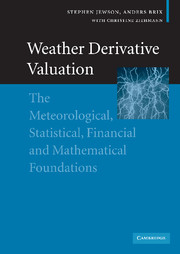 Weather Derivative Valuation
Weather Derivative Valuation Book contents
- Frontmatter
- Contents
- List of figures
- List of tables
- Acknowledgements
- 1 Weather derivatives and the weather derivatives market
- 2 Data cleaning and trends
- 3 The valuation of single contracts using burn analysis
- 4 The valuation of single contracts using index modelling
- 5 Further topics in the valuation of single contracts
- 6 The valuation of single contracts using daily modelling
- 7 Modelling portfolios
- 8 Managing portfolios
- 9 An introduction to meteorological forecasts
- 10 The use of meteorological forecasts in pricing
- 11 Arbitrage pricing models
- 12 Risk management
- 13 Modelling non-temperature data
- A Trend models
- B Parameter estimation
- C Goodness of fit tests
- D Expected pay-offs for normally distributed indices
- E Pay-off variances for normally distributed indices
- F Greeks for normally distributed indices
- G Exact solutions for the kernel density
- H The beta for a normally distributed index
- I Simulation methods
- J Efficient methods for pricing against a portfolio
- References
- Index
13 - Modelling non-temperature data
Published online by Cambridge University Press: 22 September 2009
- Frontmatter
- Contents
- List of figures
- List of tables
- Acknowledgements
- 1 Weather derivatives and the weather derivatives market
- 2 Data cleaning and trends
- 3 The valuation of single contracts using burn analysis
- 4 The valuation of single contracts using index modelling
- 5 Further topics in the valuation of single contracts
- 6 The valuation of single contracts using daily modelling
- 7 Modelling portfolios
- 8 Managing portfolios
- 9 An introduction to meteorological forecasts
- 10 The use of meteorological forecasts in pricing
- 11 Arbitrage pricing models
- 12 Risk management
- 13 Modelling non-temperature data
- A Trend models
- B Parameter estimation
- C Goodness of fit tests
- D Expected pay-offs for normally distributed indices
- E Pay-off variances for normally distributed indices
- F Greeks for normally distributed indices
- G Exact solutions for the kernel density
- H The beta for a normally distributed index
- I Simulation methods
- J Efficient methods for pricing against a portfolio
- References
- Index
Summary
In chapters 2 to 12 we have considered how to model and price weather derivatives that depend on temperature as the underlying variable. Such contracts are by far the most common, accounting for about 85 per cent of all contracts traded in 2002 according to the WRMA. However, a number of other weather variables are used too. These include precipitation, snow depth, snow fall, river flow and wind. Of these, the most commonly seen are precipitation and wind, and we focus on these two variables in this chapter. Contracts based on these variables can be priced using the same basic methods as used for temperature-based contracts (burn analysis, index modelling and daily modelling), and as with temperature one may wish to detrend the data before applying any of these methods. Burn analysis works in exactly the same way as for temperature; index modelling may involve using new index distributions to cope with the different distribution shapes that arise; daily modelling may involve new kinds of time series models.
The purpose of this chapter is not to discuss precipitation and wind modelling in the same kind of detail as we have for temperature. Rather, we provide a brief overview of some of the modelling techniques available. In each case we first discuss the most common index types and show some examples of their index distributions. We then look at models for higher-frequency variables.
Precipitation
Figure 13.1 shows the daily precipitation at Chicago O'Hare from 1958 to 2002.
- Type
- Chapter
- Information
- Weather Derivative ValuationThe Meteorological, Statistical, Financial and Mathematical Foundations, pp. 282 - 291Publisher: Cambridge University PressPrint publication year: 2005


